2012 DACIA SANDERO fuel cap
[x] Cancel search: fuel capPage 8 of 183
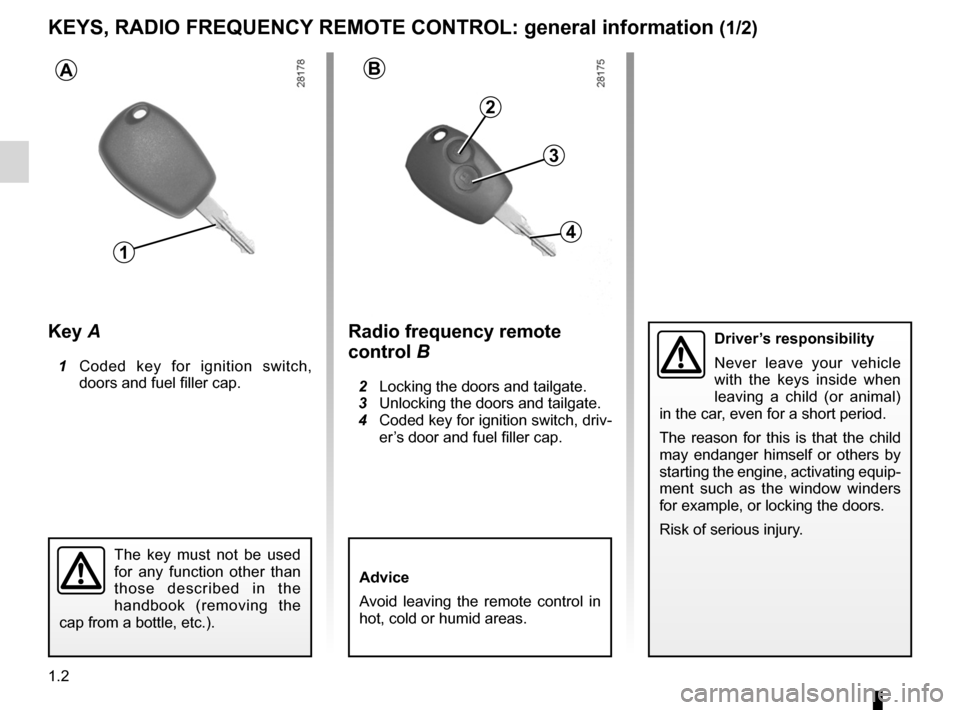
keys ...................................................... (up to the end of the DU)
remote control door locking unit ........... (up to the end of the DU)
radio frequency remote control/key use ................................................................... (current page)
child safety ............................................................. (current page)
1.2
ENG_UD18185_9
Clés / télécommande à radiofréquence: généralité\
s (B90 - L90 - F90 - U90 - R90 - L90 Ph2 - F90 Ph2 - R90 Ph2 - Dacia)
ENG_NU_817-9_B90_Dacia_1
Jaune NoirNoir texte
Keys/radio frequency remote control: general information
KEYS, RADIO FREQUENCY REMOTE CONTROL: general information (1/2)
Radio frequency remote
control B
2 Locking the doors and tailgate.
3 Unlocking the doors and tailgate.
4 Coded key for ignition switch, driv-
er’s door and fuel filler cap.
Driver’s responsibility
Never leave your vehicle
with the keys inside when
leaving a child (or animal)
in the car, even for a short period.
The reason for this is that the child
may endanger himself or others by
starting the engine, activating equip -
ment such as the window winders
for example, or locking the doors.
Risk of serious injury.Key A
1 Coded key for ignition switch,
doors and fuel filler cap.
Advice
Avoid leaving the remote control in
hot, cold or humid areas.
BA
3
2
4
1
The key must not be used
for any function other than
those described in the
handbook (removing the
cap from a bottle, etc.).
Page 52 of 183

1.46
ENG_UD20446_9
Ordinateur de bord (B90 - L90 Ph2 - F90 Ph2 - R90 Ph2 - Dacia)
ENG_NU_817-9_B90_Dacia_1
Jaune NoirNoir texte
Interpreting some of the
values displayed after
resetting
The values showing average fuel con -
sumption, range and average speed
will become more stable and reliable
the further you travel after pressing the
reset button.
For the first few miles after pressing the
reset key you will notice that the range
increases as you travel. This range
takes into account the average fuel con-
sumption since the last time the reset
button was pressed. Therefore, the fuel
consumption may decrease when:
– the vehicle stops accelerating;
– the engine reaches its operat -
ing temperature (if the engine
was cold when the reset key was
pressed);
– driving from an urban area onto
the open road;
Therefore, if the average fuel con-
sumption decreases, the range
will increase. –
You may also notice that the aver -
age fuel consumption increases
when the vehicle is stationary and
the engine idling.
This is normal, since the computer
takes account of fuel used during
idling.
Manually resetting the journey param -
eters: with the display showing one of
the journey parameters, press button 2
until the display is reset.
Automatically resetting the journey pa-
rameters: the reset is automatic when
the capacity of one of the memories is
exceeded.
TRIP COMPUTER AND WARNING SYSTEM (2/4)
The information displayed DEPENDS ON THE VEHICLE EQUIPMENT AND COUNTRY.
Page 62 of 183
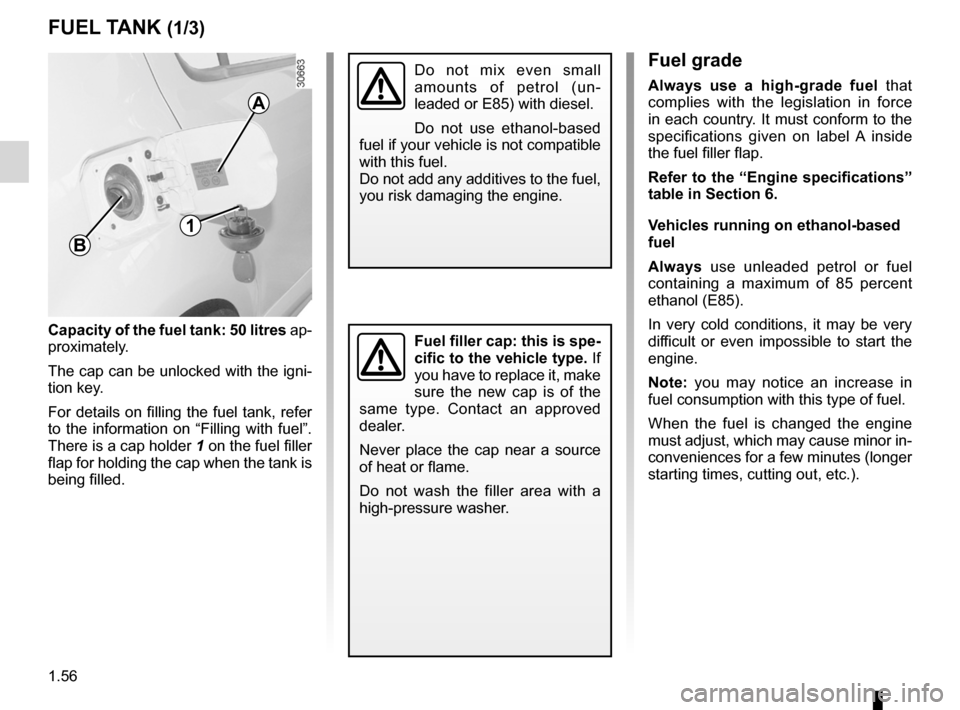
fuel filler cap .......................................................... (current page)
fuel tank capacity ................................................... (current page)
fuel grade ................................................................ (current page)
fuel tank ................................................ (up to the end of the DU)
fuel filler cap .......................................................... (current page)
fuel grade ............................................................... (current page)
1.56
ENG_UD22575_7
Réservoir carburant (B90 - Dacia)
ENG_NU_817-9_B90_Dacia_1
Jaune NoirNoir texte
Fuel tank (filling with fuel)
FUEL TANK (1/3)
Capacity of the fuel tank: 50 litres ap-
proximately.
The cap can be unlocked with the igni -
tion key.
For details on filling the fuel tank, refer
to the information on “Filling with fuel”.
There is a cap holder 1 on the fuel filler
flap for holding the cap when the tank is
being filled.
Fuel grade
Always use a high-grade fuel that
complies with the legislation in force
in each country. It must conform to the
specifications given on label A inside
the fuel filler flap.
Refer to the “Engine specifications”
table in Section 6.
Vehicles running on ethanol-based
fuel
Always use unleaded petrol or fuel
containing a maximum of 85 percent
ethanol (E85).
In very cold conditions, it may be very
difficult or even impossible to start the
engine.
Note: you may notice an increase in
fuel consumption with this type of fuel.
When the fuel is changed the engine
must adjust, which may cause minor in-
conveniences for a few minutes (longer
starting times, cutting out, etc.).
Fuel filler cap: this is spe-
cific to the vehicle type. If
you have to replace it, make
sure the new cap is of the
same type. Contact an approved
dealer.
Never place the cap near a source
of heat or flame.
Do not wash the filler area with a
high-pressure washer.
A
B
1
Do not mix even small
amounts of petrol (un -
leaded or E85) with diesel.
Do not use ethanol-based
fuel if your vehicle is not compatible
with this fuel.
Do not add any additives to the fuel,
you risk damaging the engine.
Page 72 of 183
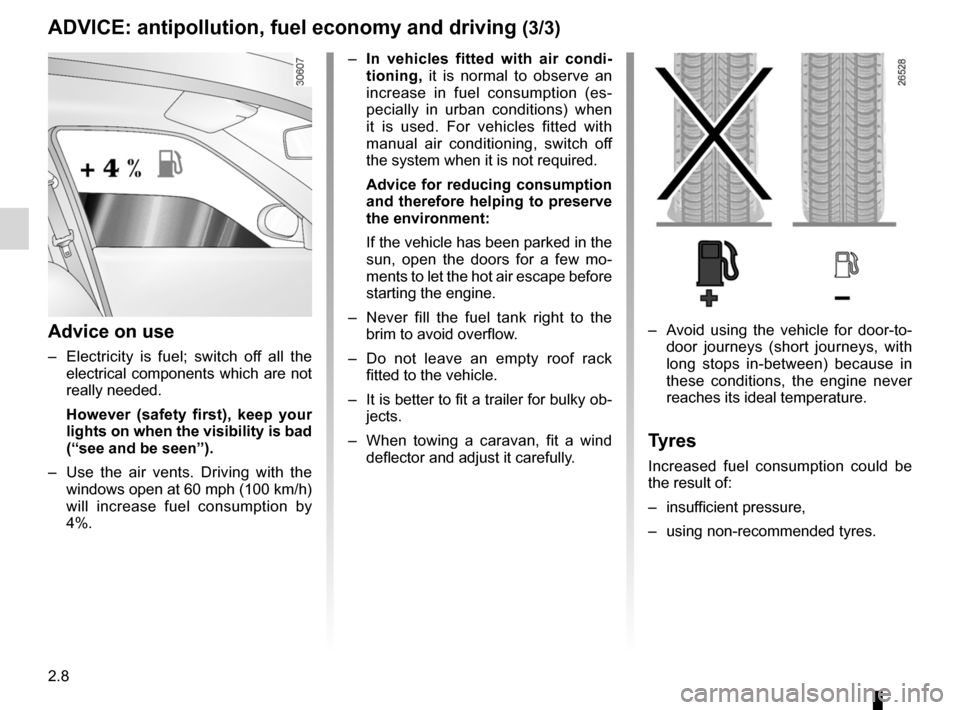
2.8
ENG_UD22287_11
Conseils : antipollution, économies de carburant, conduite (B90 - U9\
0 - L90 Ph2 - F90 Ph2 - R90 Ph2 - H79 - Dacia)
ENG_NU_817-9_B90_Dacia_2
ADVICE: antipollution, fuel economy and driving (3/3)
– In vehicles fitted with air condi -
tioning, it is normal to observe an
increase in fuel consumption (es -
pecially in urban conditions) when
it is used. For vehicles fitted with
manual air conditioning, switch off
the system when it is not required.
Advice for reducing consumption
and therefore helping to preserve
the environment:
If the vehicle has been parked in the
sun, open the doors for a few mo -
ments to let the hot air escape before
starting the engine.
– Never fill the fuel tank right to the
brim to avoid overflow.
– Do not leave an empty roof rack
fitted to the vehicle.
– It is better to fit a trailer for bulky ob-
jects.
– When towing a caravan, fit a wind
deflector and adjust it carefully.
Advice on use
– Electricity is fuel; switch off all the
electrical components which are not
really needed.
However (safety first), keep your
lights on when the visibility is bad
(“see and be seen”).
– Use the air vents. Driving with the
windows open at 60 mph (100 km/h)
will increase fuel consumption by
4%. –
Avoid using the vehicle for door-to -
door journeys (short journeys, with
long stops in-between) because in
these conditions, the engine never
reaches its ideal temperature.
Tyres
Increased fuel consumption could be
the result of:
– insufficient pressure,
– using non-recommended tyres.
Page 89 of 183
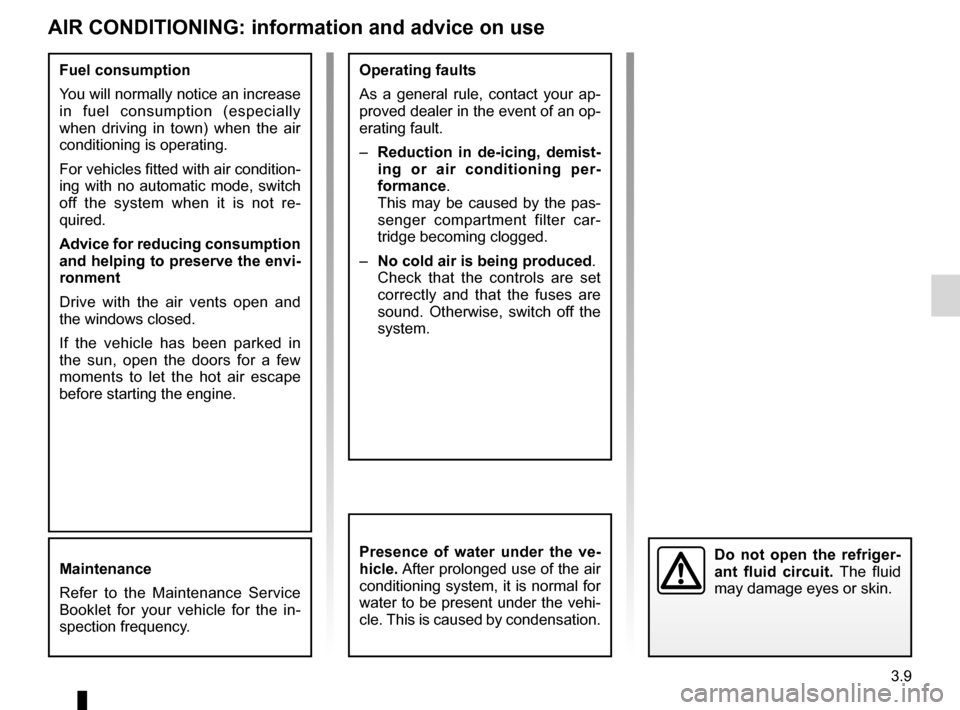
air conditioning ..................................... (up to the end of the DU)
heating system ..................................... (up to the end of the DU)
heating and air conditioning system ..... (up to the end of the DU)
ventilation heating and air conditioning system (up to the end of the DU)
air conditioning ...................................................... (current page)
3.9
ENG_UD18246_14
Air conditionné : informations et conseils utilisation (B90 - U90 - \
L90 Ph2 - F90 Ph2 - R90 Ph2 - H79 - Dacia)
ENG_NU_817-9_B90_Dacia_3
Air conditioning: information and advice on use
AIR CONDITIONING: information and advice on use
Fuel consumption
You will normally notice an increase
in fuel consumption (especially
when driving in town) when the air
conditioning is operating.
For vehicles fitted with air condition -
ing with no automatic mode, switch
off the system when it is not re -
quired.
Advice for reducing consumption
and helping to preserve the envi-
ronment
Drive with the air vents open and
the windows closed.
If the vehicle has been parked in
the sun, open the doors for a few
moments to let the hot air escape
before starting the engine. Operating faults
As a general rule, contact your ap-
proved dealer in the event of an op-
erating fault.
– Reduction in de-icing, demist -
ing or air conditioning per -
formance.
This may be caused by the pas-
senger compartment filter car -
tridge becoming clogged.
– No cold air is being produced .
Check that the controls are set
correctly and that the fuses are
sound. Otherwise, switch off the
system.
Do not open the refriger -
ant fluid circuit. The fluid
may damage eyes or skin.Presence of water under the ve -
hicle. After prolonged use of the air
conditioning system, it is normal for
water to be present under the vehi-
cle. This is caused by condensation.Maintenance
Refer to the Maintenance Service
Booklet for your vehicle for the in -
spection frequency.
Page 115 of 183
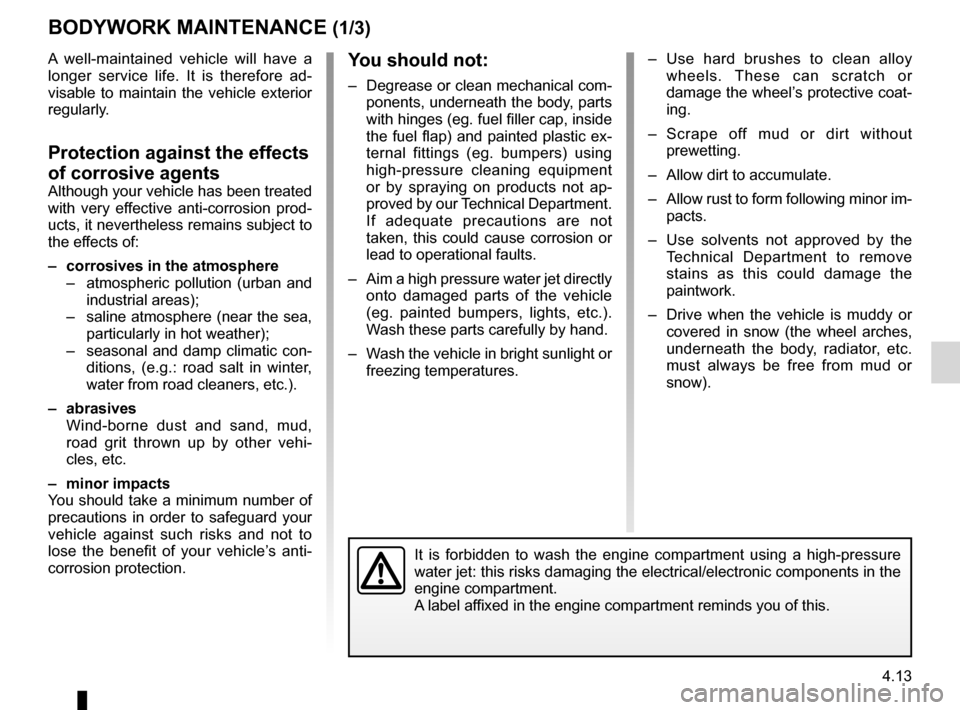
bodywork (maintenance) ...................... (up to the end of the DU)
maintenance: bodywork ........................................ (up to the end of the DU)
washing ................................................ (up to the end of the DU)
paintwork maintenance .................................................... (current page)
4.13
ENG_UD20155_5
Entretien de la carrosserie (B90 - U90 - L90 Ph2 - F90 Ph2 - R90 Ph2 - \
Dacia)
ENG_NU_817-9_B90_Dacia_4
Bodywork maintenance
BODyWORK MAINTENANCE (1/3)
A well-maintained vehicle will have a
longer service life. It is therefore ad -
visable to maintain the vehicle exterior
regularly.
Protection against the effects
of corrosive agents
Although your vehicle has been treated
with very effective anti-corrosion prod -
ucts, it nevertheless remains subject to
the effects of:
– corrosives in the atmosphere
– atmospheric pollution (urban and
industrial areas);
– saline atmosphere (near the sea,
particularly in hot weather);
– seasonal and damp climatic con-
ditions, (e.g.: road salt in winter,
water from road cleaners, etc.).
– abrasives
Wind-borne dust and sand, mud,
road grit thrown up by other vehi -
cles, etc.
– minor impacts
You should take a minimum number of
precautions in order to safeguard your
vehicle against such risks and not to
lose the benefit of your vehicle’s anti -
corrosion protection.
y ou should not:
– Degrease or clean mechanical com-
ponents, underneath the body, parts
with hinges (eg. fuel filler cap, inside
the fuel flap) and painted plastic ex-
ternal fittings (eg. bumpers) using
high-pressure cleaning equipment
or by spraying on products not ap -
proved by our Technical Department.
If adequate precautions are not
taken, this could cause corrosion or
lead to operational faults.
– Aim a high pressure water jet directly
onto damaged parts of the vehicle
(eg. painted bumpers, lights, etc.).
Wash these parts carefully by hand.
– Wash the vehicle in bright sunlight or
freezing temperatures. –
Use hard brushes to clean alloy
wheels. These can scratch or
damage the wheel’s protective coat-
ing.
– Scrape off mud or dirt without
prewetting.
– Allow dirt to accumulate.
– Allow rust to form following minor im-
pacts.
– Use solvents not approved by the
Technical Department to remove
stains as this could damage the
paintwork.
– Drive when the vehicle is muddy or
covered in snow (the wheel arches,
underneath the body, radiator, etc.
must always be free from mud or
snow).
It is forbidden to wash the engine compartment using a high-pressure
water jet: this risks damaging the electrical/electronic components in the
engine compartment.
A label affixed in the engine compartment reminds you of this.
Page 162 of 183

engine specifications ............................ (up to the end of the DU)
technical specifications ......................... (up to the end of the DU)
fuel grade ............................................... (up to the end of the DU)
engine technical specifications ................... (up to the end of the DU)
6.4
ENG_UD18029_4
Caractéristiques moteur (B90 - Dacia)
ENG_NU_817-9_B90_Dacia_6
Engine specifications
ENGINE SPECIFICATIONS
Versions 1.2 16V1.41.61.6 16V 1.5 dCi
Engine type
(see engine plate) D4F
K7JK7M K4MK9K Turbo
Cubic capacity (cc) 1,1491,390 1,5981,461
Type of fuel
Octane rating It is
essential that you use unleaded petrol of the octane rating stated on
the label inside the fuel filler flap.
If not available, for a limited time only, use unleaded fuel:
– with an octane rating of 91 for a label with the ratings 95 or 98;
– with an octane rating of 87 for a label showing 91, 95 or 98. Diesel.
The label
located in the fuel filler flap
indicates the
authorised fuels.
Spark plugs Only use the spark plugs specified for your vehicle’s engine.
The type should be marked on a label affixed inside the engine compart-
ment. If it is not, contact an approved dealer.
Fitting spark plugs which are not to specification may damage the engine.
Page 178 of 183

7.2
FRA_UD25177_11
Index (B90 - Dacia)
ENG_NU_817-9_B90_Dacia_7
Jaune NoirNoir texte
AlphAbeticAl index (2/4)
engine oil grade .......................................................... 4.5 – 4.6
engine specifications ........................................................... 6.4
environment ........................................................................\
. 2.9
F
faults operating faults ................................................ 5.34 → 5.38
filter ........................................................................\
............ 4.10
air filter ......................................................................... 4.10
diesel filter ........................................................... 1.58, 4.10
oil filter ........................................................................... 4.6
particle filter ................................................................... 2.5
passenger compartment filter ...................................... 4.10
fitting a radio ...................................................................... 5.32
fittings ..................................................................... 3.15 – 3.16
fog lights ........................................................................\
.... 1.50
front passenger air bag deactivation ................................. 1.32
front seat adjustment ........................................................... 1.9
front seats adjustment ..................................................................... 1.9
fuel advice on fuel economy ....................................... 2.6 → 2.8
grade ..................................................................... 1.56, 6.4
fuel economy ............................................................. 2.6 → 2.8
fuel filler cap ...................................................................... 1.56
fuel grade ........................................................................\
... 1.56
fuel level ........................................................................\
.... 1.44
fuel priming bulb ................................................................ 1.58
fuel tank ................................................................. 1.56 → 1.58
fuel tank capacity ............................................................... 1.56
fuses ...................................................................... 5.22 → 5.24
G
gear lever ........................................................................\
... 2.10
glove box ........................................................................\
... 3.15
grab handle ........................................................................\
3.13h
handbrake
........................................................................\
.. 2.11
hazard warning lights signal .............................................. 1.52
headlight beam adjustment ............................................... 1.51
headlight flashers .............................................................. 1.52
headrest ...................................................................... 1.8, 3.17
heating and air conditioning system ................... 3.2 → 3.5, 3.9
heating system .......................................................... 3.2 → 3.9
horn ........................................................................\
........... 1.52
i
ignition switch ...................................................................... 2.2
indicator lights .................................................................... 5.18
indicators .................................................................. 1.52, 5.14
indicators: direction indicators ....................................................... 1.52
instrument panel .................................................... 1.40 → 1.44
interior trim maintenance ..................................................... 4.16 – 4.17
J
jack .................................................................... 5.2, 5.9 – 5.10
K
keys ........................................................................\
.... 1.2 – 1.3
replacing the battery .................................................... 5.27
l
levels .................................................................. 4.4, 4.7 → 4.9
levels: engine oil ....................................................................... 4.5
lifting the vehicle changing a wheel ............................... 5.2 – 5.3, 5.7 → 5.10
lighting: exterior ......................................... 1.49 – 1.50, 5.14 → 5.18
interior ..................................................... 3.10, 5.19 → 5.21